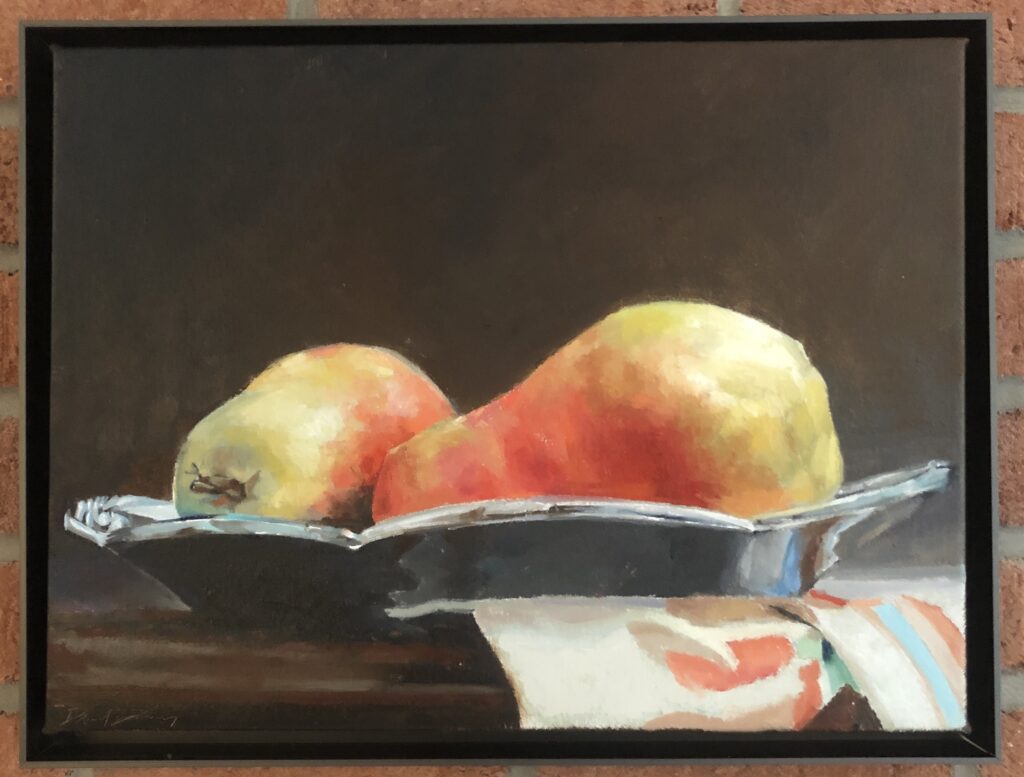Bartlett Pears, Redux

Bartlett Pears, 12″ x 16″, oil on linen
My life the past two years has toggled between slow-burning family emergencies punctuated by intervals of regular, predictable daily hours of painting. The crises have morphed into ongoing obligations to care for family members who need assistance, but this is a shift toward regularity that allows me to restore the concentrated, monotonous, repetitive attention essential for painting. I’m finally emerging from unpredictable interruptions and, if I’m lucky, I’m hoping I can look forward to quite a few years of being able to put in significant daily hours of work. It’s what I need to finish a suite of paintings I started more than two years ago: images of salt-water taffy I haven’t been posting because I want to complete most of the whole series in order to decide what to put on view. I’ve completed only ten of these paintings so far—even the smaller ones have taken four to six weeks, with six weeks as the average for painting the largest of them. Even at that deliberate rate, I should have completed far more than ten, but for the entire summer two years ago while providing care for my father I was unable to sit at the easel and then I had several months helping my brother get my mom’s life in order in his absence. Then my son and daughter-in-law left California to stay here in Rochester during the pandemic, finally deciding to actually move here when Laura realized she could work remotely as a video producer—which Matthew may be able to do as well once they hire help for childcare. A freak automobile accident created a situation similar to what we faced with my father two years ago—but Laura eventually recovered enough for them to buy and move into a home a mile away. And then she had a baby, their second son. Her recovery and the new grandchild are a blessing, but also—in a wonderful way—it has provided fresh excuses to do things other than paint. All of this has prompted me to go dormant for periods on Instagram and this blog, still working pretty diligently, but not communicating much about what I’ve been doing.
Next month I should be able to restore the daily/hourly discipline I enjoyed two years ago and eventually finish my series of salt-water taffy paintings and offer them as a solo show. Meanwhile, as a balance to the deliberate, painstaking work on the salt-water taffy paintings—they are not hyper-realistic; the marks are visible up close, as usual, sometimes for better, sometimes for worse (in my view)—I’ve started a side practice of doing small, traditional paintings with a quicker, more painterly technique. As the first in this line, last week I finished a second version of a painting I did more than a dozen years ago, two Bartlett pears in a small metal dish. It’s a second version of the first painting I ever entered into a juried exhibition—my first entry was also my first acceptance—at the Arkell Museum. This version required four days, but could have been finished in two. I’m pleased with the results, but it was a fascinating learning experience. At every turn in the process, I recognized my ability to get the image convincingly close to the original painting, but also saw how impossible it was to duplicate the exact tone of the original paint. There’s an almost greenish undertone at the bottom of the foreground pear, in the dents, a marvelous cool tone I came up with mixing who-knows-what color into another. It was enjoyable to look at my past work and react the way I do when I see work that impresses me from other painters: How did that happen? The impression this painting gives, now that it’s complete, is virtually identical to what I see when I glance at a photograph of the first painting, but in each detail, the color is slightly different from what I mixed while painting the first version. The relationship among all the tones is what holds up between the earlier painting and this new one. I did this once before—doing a second version of an earlier painting—with a small painting of a sugar bowl I exhibited at the Butler Institute of American Art. In that case, I discovered that I actually preferred the second version to the first. I don’t plan on doing a slew of new versions of old paintings. I want to embark on a new set of small, simple still lifes—with a less assiduous attention to photographic detail, more emphasis on “putting one spot of color next to another spot of color” in a way that captures how light falls on various colors and forms. I hope to make the character of the paint on the surface of the canvas part of what gives the viewer pleasure. What I’m hoping is to experience the pleasure of actually finishing a painting a bit more often than the taffy paintings have afforded.
We’ll see if successive efforts lead me toward some insights I can apply to the more strenuous project of the large taffy paintings—I’m already discovering many new things to keep in mind in those paintings, new personal guidelines I discovered as I finished the tenth one a month ago. Also, I’m planning to have a new studio built as an addition to our home this summer as well—so, in preparation for the construction I’ve moved into a more confined space at the moment, while looking forward to the largest and brightest studio I will have ever had. I’m determined not to let the construction distract me from my own work, but I know how that goes, based on the past two years . . .
Comments are currently closed.